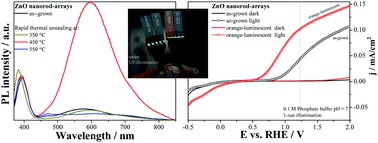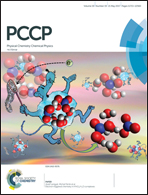Defect-promoted photo-electrochemical performance enhancement of orange-luminescent ZnO nanorod-arrays†
Abstract
Intentionally defect-rich zinc oxide (ZnO) nanorod-arrays were grown from solution by carefully adjusting the concentration ratio of the growth-precursors used followed by various post-deposition thermal treatments. Post-deposition rapid thermal annealing (RTA) at moderate temperatures (350 °C–550 °C) and in various atmospheres was applied to vary the defect composition of the grown nanorod-arrays. It is demonstrated that, intense, defect-related orange emission occurs solely upon RTA around 450 °C and is essentially independent of the atmosphere used. Extensive materials characterization was carried out in order to evaluate the origin of the orange-luminescent defects and what influence they have on the ZnO material properties. It is concluded that the oxygen vacancy–zinc interstitial defect complex (VO–Zni) is responsible for the orange luminescence in the prepared materials. A kinetic formation mechanism of the VO–Zni complex dependent on the RTA temperature is proposed and shown to be in accordance with the experimental findings. Furthermore it is shown that this bulk deep-level defect could act as a trap state for photo-generated electrons prolonging the charge carrier lifetime of photo-generated holes and therefore improving the charge carrier separation in the material. As a result the photo-current density under simulated sunlight is found to increase by almost 150% over as-grown samples. The potential use of this defective material in applications such as solar water splitting is outlined.



 Please wait while we load your content...
Please wait while we load your content...